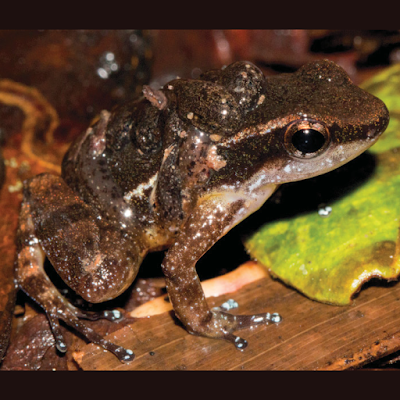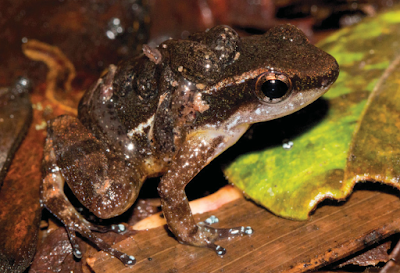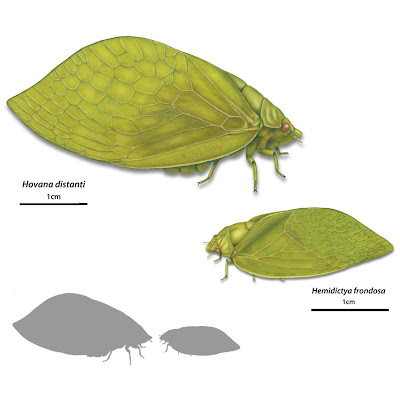[Most Recent Entries] [Calendar View]
Friday, March 13th, 2020
| Time | Event | ||||
| 3:12a | [Herpetology • 2019] Anomaloglossus mitaraka • A New Species of Anomaloglossus (Anura: Aromobatidae) of the stepheni group
Abstract Anomaloglossus is a species-rich genus of frogs endemic to the Guiana Shield that still harbors several unnamed species. Within the A. stepheni species group (which includes four valid nominal species), A. baeobatrachus has an uncertain taxonomic status, notably because the holotype was an unvouchered specimen depicted in a popular journal. Another member of this group, A. leopardus, was only superficially described, lacking information on the sex of specimens in the type series and on advertisement call. Therefore, these two taxa need clarifications in order to allow the description of the extant undescribed species. In this paper, we redescribe A. baeobatrachus based on newly collected material from the species type locality and provide information about its reproductive ecology. We also provide an amended definition of A. leopardus using newly collected material from its type locality. These two species form a clade along with a third species from the Eastern Guiana Shield, which is also described herein. The reproductive biology of A. baeobatrachus and A. stepheni is very similar. Both species have endotrophic and nidicolous tadpoles, despite being distantly related, suggesting independent evolution of this breeding mode. The new species and A. leopardus, on the other hand, have exotrophic tadpoles. Keywords: Amphibia, Amazonia, Endemism, Endotrophy, Guiana Shield, Reproductive mode, Taxonomy
Anomaloglossus mitaraka sp. nov. Anomaloglossus sp. “Mitaraka” Vacher et al. 2017 Etymology. The specific epithet is a noun in apposition and refers to the type locality (Mitaraka, French Guiana). Antoine Fouquet, Jean-Pierre Vacher, Elodie A. Courtois, Chloé Deschamps, Paul Ouboter, Rawien Jairam, Philippe Gaucher, Alain Dubois and Philippe J.R. Kok. 2019. A New Species of Anomaloglossus (Anura: Aromobatidae) of the stepheni group with the Redescription of A. baeobatrachus (Boistel and de Massary, 1999), and An Amended Definition of A. leopardus Ouboter and Jairam, 2012. Zootaxa. 4576(3); 439-460. DOI: 10.11646/zootaxa.4576.3.2 Chez les grenouilles, s’hybrider en ayant des modes de reproduction distincts c’est possible ! Antoine Fouquet, Berengère Ferrier, Jordi Salmona, et al., 2019. Phenotypic and Life-history Diversification in Amazonian Frogs despite Past Introgressions. Molecular Phylogenetics and Evolution. 130; 169-180. DOI: 10.1016/j.ympev.2018.09.010 | ||||
| 3:17a | [Entomology • 2020] Redefinition of the Cicada Tribe Hemidictyini Distant, 1905 (Hemiptera: Cicadidae), Status of the Tribe Iruanini Boulard, 1993 rev. stat., and the Establishment of Hovanini n. tribe and Sapantangini n. tribe
Abstract A recent paper by Ruschel & Campos (2019) on “leaf-winged” cicadas proposed a significant reorganization of the cicada tribe Hemidictyini Distant, 1905g, including synonymization of the monogeneric tribe Lacetasini Moulds & Marshall, 2018 following the results of a cladistic parsimony analysis of morphological characters. In this study, we reconsider and revise the morphological analysis of Ruschel & Campos and obtain new genetic data for Hemidictya. We find that their study suffers from a limited taxon sample, inappropriate outgroup selection, and misinterpretation of genitalic characters (uncus vs. claspers). We show that Hemidictyini sensu Ruschel & Campos includes members of multiple tribes and subfamilies, and we conclude that some of the taxonomic transfers by Ruschel & Campos are not supported. The two most similar and leaf-like cicadas, Hemidictya Burmeister, 1835 (South America) and Hovana Distant, 1905g (Madagascar), are probably not closely related but rather an excellent example of convergent evolution. Lacetasini is not a junior synonym of the Hemidictyini but a distinct part of the Tettigomyiinae Distant, 1905g as originally classified. We return or transfer the genera Lacetas Karsch, 1890, Iruana Distant, 1905g, Bafutalna Boulard, 1993, and Murphyalna Boulard, 2012 to the Lacetasini. With the transfer of all genera of Iruanina Boulard, 1993 and Bafutalnina Boulard, 1993 to Lacetasini and with Lacetas transferred to the Iruanina, Lacetasini n. syn. becomes a subjective junior synonym of Iruanini rev. stat. in the Tettigomyiinae. We assign Hovana to Hovanini n. tribe in the Tettigomyiinae and Sapantanga Distant, 1905g to Sapantangini n. tribe in the Tibicininae Distant, 1905b. We propose that Hemidictyini sensu novo contains only the genus Hemidictya and we assign the tribe to Tibicininae with a revised diagnosis.
Allen F. Sanborn, David C. Marshall, Maxwell S. Moulds, Stéphane Puissant and Chris Simon. 2020. Redefinition of the Cicada Tribe Hemidictyini Distant, 1905, Status of the Tribe Iruanini Boulard, 1993 rev. stat., and the Establishment of Hovanini n. tribe and Sapantangini n. tribe (Hemiptera: Cicadidae). Zootaxa. 4747(1); 133–155. DOI: 10.11646/zootaxa.4747.1.5 |
| << Previous Day |
2020/03/13 [Calendar] |
Next Day >> |





